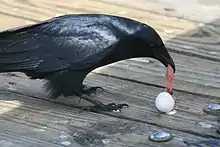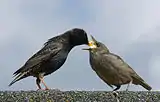Egg predation
Egg predation is a feeding strategy by animals (ovivores) including fish, birds, snakes and insects, in which they consume the eggs of other species. Since an egg represents a complete organism at one stage of its life cycle, eating an egg is a form of predation, the killing of another organism for food.

Egg predation is found widely across the animal kingdom, including in insects such as ladybirds, annelids such as the leech Cystobranchus virginicus, fishes such as haddock, snakes such as colubrids, birds such as carrion crow and buzzard, and mammals such as red fox, badgers and pine martens. Some species are specialist egg predators, but many more are generalists which take eggs when the opportunity arises.
Snakes specialising in egg predation have greatly reduced venom, implying that the main function of venom is to subdue prey.
Ecological relationship

Egg predation is an ecological relationship in which an animal (a predator) hunts for and eats the eggs of another (prey) species. This reduces the evolutionary fitness of the parents whose eggs are preyed on. Among birds such as eider ducks in one study, half the individuals started a fresh clutch of eggs, always in a new nest, and they always avoided the area around the robbed nest.[2] Egg predation rates can be high for ground-nesting birds such as the European golden plover, Pluvialis apricaria: in Norway 78.2% of nests of this species were preyed on. Experimental removal of two nest and egg predators, red fox and carrion crow, in another study raised the percentage of pairs that fledged young from c. 18% to c. 75%. Population increases among many generalist predators such as buzzard, badger, carrion crow, pine marten, raven, and red fox in Scotland have contributed to the decline in several ground-nesting bird species by taking eggs, young, and sitting hen (female) birds.[3]
Among fish, egg predation by species such as haddock (Melanogrammus aeglefinus) can contribute to the decline in other fish populations such as of Atlantic herring (Clupea harengus). This effect can be important in attempts to restore fisheries damaged by overfishing.[4]
Invasive species such as the harlequin ladybird Harmonia axyridis frequently prey on eggs and young of native species, in its case including those of other ladybirds such as the two-spot ladybird Adalia bipunctata. Females of the prey species laid eggs with higher amounts of defensive alkaloids when egg predation was occurring.[5]
Some colubrid snakes such as the Formosa kukri snake Oligodon formosanus specialise in egg predation.[6] Egg predation by snakes is rarely opposed, but the Asian long-tailed skink Eutropis longicaudata aggressively protects its eggs from the Formosa kukri snake.[7][8]
Egg-eating snakes such as the marbled sea snake Aipysurus eydouxii have atrophied venom glands; this has been explained as an evolutionary consequence of their diet, since venom is not required to subdue their prey, unlike the case in their venomous and conventionally predatory ancestors.[9]
The aquatic piscicolid leech Cystobranchus virginicus is an egg predator; it may be an obligate egg-feeder as it has not been seen feeding on an adult but has been found in the nests of a variety of species of North American freshwater fish of the genera Campostoma and Moxostoma.[10]
References
- Goodwin, D. (1983). Crows of the World. Queensland University Press. p. 92. ISBN 0-7022-1015-3.
- Hanssen, Sveinn Are; Erikstad, Kjell Einar (2012). "The long-term consequences of egg predation". Behavioral Ecology. 24 (2): 564–569. doi:10.1093/beheco/ars198.
- Ainsworth, Gill; Calladine, John; Martay, Blaise; Park, Kirsty; Redpath, Steve; Wernham, Chris; Wilson, Mark; Young, Juliette (2017). Understanding Predation | A review bringing together natural science and local knowledge of recent wild bird population changes and their drivers in Scotland. Scotland's Moorland Forum. pp. 233–234.
- Richardson, D. E.; Hare, J. A.; Fogarty, M. J.; Link, J. S. (2011). "Role of egg predation by haddock in the decline of an Atlantic herring population". Proceedings of the National Academy of Sciences. 108 (33): 13606–13611. doi:10.1073/pnas.1015400108. PMC 3158212. PMID 21825166.
- Paul, Sarah C.; Stevens, Martin; Burton, Jake; Pell, Judith K.; Birkett, Michael A.; Blount, Jonathan D. (2018). "Invasive Egg Predators and Food Availability Interactively Affect Maternal Investment in Egg Chemical Defense". Frontiers in Ecology and Evolution. 6. doi:10.3389/fevo.2018.00004.
- Pike, David A.; Clark, Rulon W.; Manica, Andrea; Tseng, Hui-Yun; Hsu, Jung-Ya; Huang, Wen-San (2016-02-26). "Surf and turf: predation by egg-eating snakes has led to the evolution of parental care in a terrestrial lizard". Scientific Reports. 6 (1). doi:10.1038/srep22207. PMC 4768160. PMID 26915464.
- "Snakes meet their match in offspring-protecting lizards". Phys.org. 30 January 2013. Retrieved 11 September 2018.
- Huang, Wen-San; Lin, Si-Min; Dubey, Sylvain; Pike, David A. (2012). Coulson, Tim (ed.). "Predation drives interpopulation differences in parental care expression". Journal of Animal Ecology. 82 (2): 429–437. doi:10.1111/1365-2656.12015.
- Li, Min; Fry, B.G.; Kini, R. Manjunatha (2005). "Eggs-Only Diet: Its Implications for the Toxin Profile Changes and Ecology of the Marbled Sea Snake (Aipysurus eydouxii)". Journal of Molecular Evolution. 60 (1): 81–89. doi:10.1007/s00239-004-0138-0. PMID 15696370.
- Light, Jessica E.; Fiumera, Anthony C.; Porter, Brady A. (2005). "Egg-feeding in the freshwater piscicolid leech Cystobranchus virginicus (Annelida, Hirudinea)". Invertebrate Biology. 124 (1): 50–56. doi:10.1111/j.1744-7410.2005.1241-06.x.

